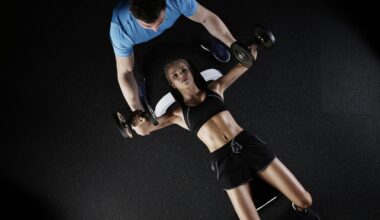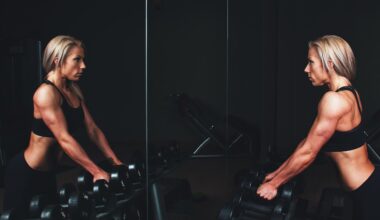Adapting Aerobic Dance Warmups for Older Adults
Aerobic dance warmups are essential for enhancing cardiovascular fitness and flexibility, especially among older adults. To effectively adapt these warmups, consider the unique physical abilities and limitations that may accompany aging. Begin with gentle movements that encourage range of motion, using simple arm and leg motions. These should avoid high-impact steps that can strain the joints. A focus on balance is paramount, incorporating slow movements that promote stability. Music selection is important as well; choose upbeat tunes at a moderate pace to keep the mood lively. Demonstrating each movement clearly is essential, providing clear instructions to participants. Visual cues can supplement verbal instructions. Warmup sessions should begin with a thorough introduction that explains the purpose of each exercise. Encourage participants to be mindful of their bodies, listening to their limits. Regularly checking in with participants about how they feel can enhance safety and encourage participation. Moreover, ensuring a supportive environment where everyone feels comfortable expressing their needs fosters a positive group dynamic and enhances the overall experience of aerobic dance warmups among older adults.
A crucial aspect of adapting aerobic dance warmups involves segmenting the workout into manageable portions. Segmenting allows older adults to focus on specific movements without feeling overwhelmed. Start with a light upper-body warmup that includes shoulder rolls, gentle arm swings, and neck stretches. Gradually introduce lower-body movements like ankle raises, toe taps, and leg lifts. Encouraging proper posture during these exercises can prevent injuries. Modify movements to fit individual capabilities; for instance, some participants may prefer seated options. Provide clear options, explaining how each movement can be adapted according to their personal comfort levels. Additionally, ensure that the room has enough space for everyone to move freely without risks. Keeping the atmosphere relaxed can motivate participants to engage enthusiastically. Instructors should also encourage participants to inform them if something feels uncomfortable. If physical limitations exist, utilize props like chairs or resistance bands to assist with movements. Encourage interaction among participants, creating camaraderie that can boost morale significantly. A supportive community setting promotes an environment where older adults feel empowered to participate fully and enjoy the benefits of aerobic dance warmups.
Safety Considerations
Safety is paramount when conducting aerobic dance warmups for older adults. Always perform a basic health screening before starting, ensuring participants are cleared for physical activity. Briefly discussing physical limitations and preferences will foster a spirit of inclusion. Emphasizing joint safety is critical; exercises should focus on low-impact movements that minimize stress on the knees and hips. Instructors should demonstrate proper techniques for moves, highlighting the importance of avoiding abrupt or jerky motions. Clearly stating guidelines on maintaining a safe space is vital, ensuring no obstacles in the workout area that could cause trips or falls. Demonstrating how to safely exit or modify exercises if fatigue arises is also essential; resting between segments can help maintain energy levels without risk. Encourage participants to hydrate frequently throughout the session, as keeping hydrated is crucial for everyone, especially older adults. Monitoring the intensity of the workout is also important; it is advisable to keep sessions at a conversational pace. The priority should always be comfort and safety, permitting everyone to enjoy the benefits of engaging in aerobic dance warmups meaningfully.
Incorporating variety into aerobic dance warmups can significantly enhance engagement. Consider alternating between different styles or themes to keep sessions fresh and exciting. Examples include mixing elements of salsa, swing, or line dance into the warmup routine. You can also introduce props such as scarves or light weights to make movements more dynamic. Doing so not only encourages creativity but also can help participants remain physically motivated and engaged. A great approach is to schedule theme days where participants can wear costumes or colors that match the day’s chosen style. To foster memory and cognitive engagement, often repeating sequences or integrating familiar songs can assist retention. Research shows that cognitive function improves with structured movement and regular social interaction, making varied warmup approaches beneficial. Establish feedback sessions where group members can suggest their favorite styles or songs for future routines can foster a sense of ownership. Listening to participants’ preferences can help tailor the classes better, enhancing overall satisfaction. Thus, maintaining an adaptable approach encourages continual improvement and fosters a more enjoyable environment for older adults participating in aerobic dance warmups.
Building Community and Connections
Fostering a sense of community is vital to the success of aerobic dance warmups for older adults. Encourage social interactions before and after sessions, allowing participants to form friendships. This can significantly enhance motivation and participation over time. Using icebreaker games or group introductions can facilitate initial connections among participants. Celebrating milestones or achievements regularly will further strengthen bonds within the group. Maintain a welcoming atmosphere where everyone feels valued and heard by allowing participants to share their experiences or favorite music choices. Implementing partner exercises can also boost camaraderie, encouraging individuals to get to know one another in a relaxed setting. Creating small groups for specific activities can enhance collaboration and teamwork, making the experience more enjoyable. In addition, hosting regular events or dance showcases encourages community involvement beyond the classes. Involving families and caregivers can boost attendance and engagement, creating a more holistic environment around fitness. By embracing community-building strategies within aerobic dance warmups, groups can foster lasting relationships that contribute to better physical and emotional health for older adults.
Evaluating the program’s effectiveness is crucial for ongoing improvement. Gathering feedback from participants after each session allows instructors to make necessary adjustments, ensuring everyone’s needs are being met. Creating anonymous feedback forms can encourage honesty and deeper insights, driving enhancements to the class structure. Consider holding quarterly meetings where participants can voice their thoughts collectively about the classes they attended. Conducting assessments on physical progress can help tailor routines that suit participants more effectively. Tracking attendance can also provide insights into motivation levels and program satisfaction. Instructors should remain responsive and flexible, adjusting various elements of the warmup if needed. Incorporating new music or exercises based on participant input keeps classes vibrant and aligning with their interests. End-of-session reflections can give a space for everyone to share what they enjoyed and suggest new activities. This fosters a sense of ownership among participants, encouraging deeper commitment to the program. Continually monitoring and evolving the classes help ensure they remain relevant and beneficial for older adults participating in aerobic dance warmups.
Conclusion and Future Directions
In conclusion, adapting aerobic dance warmups for older adults requires a thoughtful approach to accommodate their unique needs. Prioritizing safety, engagement, and community building ensures a positive and enjoyable experience. Regular assessments allow instructors to make adjustments that keep the classes vibrant and effective. Future directions could involve expanding offerings to include diverse age groups or skill levels, thereby enriching communal ties. Collaborating with healthcare professionals can provide valuable insights into program adjustments and overall well-being. Furthermore, exploring online platforms or virtual classes could increase accessibility for those unable to attend in-person sessions. Hosting workshops or seminars on the benefits of dance and movement can expand awareness and offer support. There is also potential for developing training programs specifically for instructors, equipping them to meet the distinct needs of older adults effectively. These steps not only enhance individual experiences but also promote overall health within the community. As more older adults embrace fitness through aerobic dance warmups, fostering a robust, inclusive environment remains essential for their well-being and continued participation.
Incorporating a feedback loop ensures programs remain responsive to participants’ evolving needs. Regular evaluation not only gathers insights on physical activity levels but also measures participants’ emotional satisfaction. Moreover, future goals should focus on expanding these classes into the community by collaborating with local organizations. By nurturing connections with local gyms, community centers, or senior organizations, we can create outreach programs that encourage broader participation. Providing scholarships or free trial classes would make these warmups more accessible to those on fixed incomes. Emphasizing an inclusive sentiment, creating classes aimed specifically at individuals with mobility challenges will strengthen community ties. Desirable activities might include chair aerobics or seated dance options that ensure no one is left out. Ultimately, adapting aerobic dance warmups for older adults is an ongoing journey. It requires commitment to meet demands through education, collaboration, and creativity. By fostering a culture of encouragement and inclusiveness, the aerobic dance community will continue thriving. Engaging older adults in enjoyable and beneficial workouts will promote their health and well-being both physically and socially.


